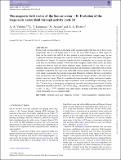Files in this item
The magnetic field vector of the Sun-as-a-star – II. Evolution of the large-scale vector field through activity cycle 24
Item metadata
| dc.contributor.author | Vidotto, A. A. | |
| dc.contributor.author | Lehmann, L. T. | |
| dc.contributor.author | Jardine, M. | |
| dc.contributor.author | Pevtsov, A. A. | |
| dc.date.accessioned | 2018-09-17T15:30:06Z | |
| dc.date.available | 2018-09-17T15:30:06Z | |
| dc.date.issued | 2018-10-11 | |
| dc.identifier | 255878534 | |
| dc.identifier | eaff15b0-f3c6-4221-8e39-ff7e69e4cae9 | |
| dc.identifier | 85052594063 | |
| dc.identifier | 000442567900039 | |
| dc.identifier.citation | Vidotto , A A , Lehmann , L T , Jardine , M & Pevtsov , A A 2018 , ' The magnetic field vector of the Sun-as-a-star – II. Evolution of the large-scale vector field through activity cycle 24 ' , Monthly Notices of the Royal Astronomical Society , vol. 480 , no. 1 , pp. 477-487 . https://doi.org/10.1093/mnras/sty1926 | en |
| dc.identifier.issn | 0035-8711 | |
| dc.identifier.other | RIS: urn:AB4315EAC2343DE9824EDD11670C64DA | |
| dc.identifier.other | ORCID: /0000-0002-1466-5236/work/57821804 | |
| dc.identifier.uri | https://hdl.handle.net/10023/16040 | |
| dc.description | LTL acknowledges support from the Scottish Universities Physics Alliance (SUPA) prize studentship and the University of St Andrews Higgs studentship. AAP acknowledges partial support by NASA grant NNX15AN43G. National Solar Observatory is operated by the Association of Universities for Research in Astronomy (AURA) Inc., under a Cooperative agreement with the National Science Foundation. | en |
| dc.description.abstract | In this work, we investigate how the large-scale magnetic field of the Sun, in its three vector components, has evolved during most of cycle 24, from 2010 January to 2018 April. To filter out the small-scale field of the Sun, present in high-resolution synoptic maps, we use a spherical harmonic decomposition method, which decomposes the solar field in multipoles with different ℓ degrees. By summing together the low-ℓ multipoles, we reconstruct the large-scale field at a resolution similar to observed stellar magnetic fields, which allows the direct comparison between solar and stellar magnetic maps. During cycle 24, the ‘Sun-as-a-star’ magnetic field shows a polarity reversal in the radial and meridional components, but not in the azimuthal component. The large-scale solar field remains mainly poloidal with ≥70 per cent of its energy contained in the poloidal component. During its evolution, the large-scale field is more axisymmetric and more poloidal when near minima in sunspot numbers, and with a larger intensity near maximum. There is a correlation between toroidal energy and sunspot number, which indicates that spot fields are major contributors to the toroidal large-scale energy of the Sun. The solar large-scale magnetic properties fit smoothly with observational trends of stellar magnetism reported in See et al. The toroidal (⟨B2tor⟩) and poloidal (⟨B2pol⟩) energies are related as ⟨B2tor⟩ α ⟨B2pol⟩1.38±0.04. Similar to the stellar sample, the large-scale field of the Sun shows a lack of toroidal non-axisymmetric field. | |
| dc.format.extent | 11 | |
| dc.format.extent | 4251069 | |
| dc.language.iso | eng | |
| dc.relation.ispartof | Monthly Notices of the Royal Astronomical Society | en |
| dc.subject | Methods: analytical | en |
| dc.subject | Magnetic topology | en |
| dc.subject | Surface magnetism | en |
| dc.subject | Magnetic fields | en |
| dc.subject | QB Astronomy | en |
| dc.subject | QC Physics | en |
| dc.subject | DAS | en |
| dc.subject.lcc | QB | en |
| dc.subject.lcc | QC | en |
| dc.title | The magnetic field vector of the Sun-as-a-star – II. Evolution of the large-scale vector field through activity cycle 24 | en |
| dc.type | Journal article | en |
| dc.contributor.sponsor | Science & Technology Facilities Council | en |
| dc.contributor.sponsor | Science & Technology Facilities Council | en |
| dc.contributor.institution | University of St Andrews. School of Physics and Astronomy | en |
| dc.identifier.doi | https://doi.org/10.1093/mnras/sty1926 | |
| dc.description.status | Peer reviewed | en |
| dc.identifier.grantnumber | ST/R00824/1 | en |
| dc.identifier.grantnumber | ST/M001296/1 | en |
This item appears in the following Collection(s)
Items in the St Andrews Research Repository are protected by copyright, with all rights reserved, unless otherwise indicated.

